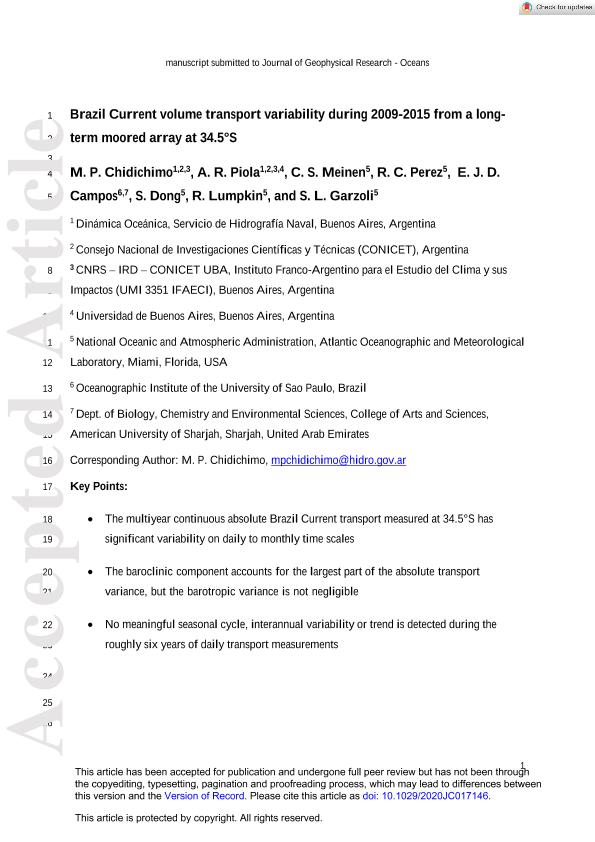Mostrar el registro sencillo del ítem
dc.contributor.author
Chidichimo, María Paz

dc.contributor.author
Piola, Alberto Ricardo

dc.contributor.author
Meinen, Christopher S.

dc.contributor.author
Perez, Renellys
dc.contributor.author
Campos, Edmo

dc.contributor.author
Dong, Shenfu
dc.contributor.author
Lumpkin, Rick
dc.contributor.author
Garzoli, S. L.
dc.date.available
2022-04-11T15:12:05Z
dc.date.issued
2021-04-07
dc.identifier.citation
Chidichimo, María Paz; Piola, Alberto Ricardo; Meinen, Christopher S.; Perez, Renellys; Campos, Edmo; et al.; Brazil Current volume transport variability during 2009-2015 from a longterm moored array at 34.5°S; American Geophysical Union; Journal of Geophysical Research: Oceans; 126; 5; 7-4-2021; 1-25
dc.identifier.issn
2169-9275
dc.identifier.uri
http://hdl.handle.net/11336/154906
dc.description.abstract
The Brazil Current, the western limb of the subtropical gyre of the South Atlantic Ocean, is one of the major Western Boundary Currents of the global ocean. Here, we present the first multiyear continuous daily time series of Brazil Current absolute volume transport obtained using 6+ years of observations from a line of four pressure-recording inverted echo sounders (PIES) deployed at 34.5°S. The array was augmented in December 2012 with two current meter-equipped PIES and in December 2013 with a moored Acoustic Doppler Current Profiler on the upper continental slope. The Brazil Current is bounded by the sea surface and the neutral density interface separating South Atlantic Central Water and Antarctic Intermediate Water, which is on average at a reference pressure of 628 ± 46 dbar, and it is confined west of 49.5°W. The Brazil Current has a mean strength of −14.0 ± 2.8 Sv (1 Sv ≡ 106 m3 s−1; negative indicates southward flow) with a temporal standard deviation of 8.8 Sv and peak-to-peak range from −41.7 to +20 Sv. About 80% of the absolute transport variance is concentrated at periods shorter than 150 days with a prominent peak at 100 days. The baroclinic component accounts for 85% of the absolute transport variance, but the barotropic variance is not negligible. The baroclinic and barotropic transports are uncorrelated, demonstrating the need to measure both transport components independently. Given the energetic high frequency transport variations, statistically significant seasonal to interannual variability and trends have yet to be detected.
dc.format
application/pdf
dc.language.iso
eng
dc.publisher
American Geophysical Union

dc.rights
info:eu-repo/semantics/openAccess
dc.rights.uri
https://creativecommons.org/licenses/by/2.5/ar/
dc.subject
BRAZIL CURRENT
dc.subject
MERIDIONAL OVERTURNING CIRCULATION
dc.subject
OBSERVATIONS
dc.subject
TRANSPORT ARRAY
dc.subject
VARIABILITY
dc.subject
VOLUME TRANSPORT
dc.subject.classification
Oceanografía, Hidrología, Recursos Hídricos

dc.subject.classification
Ciencias de la Tierra y relacionadas con el Medio Ambiente

dc.subject.classification
CIENCIAS NATURALES Y EXACTAS

dc.title
Brazil Current volume transport variability during 2009-2015 from a longterm moored array at 34.5°S
dc.type
info:eu-repo/semantics/article
dc.type
info:ar-repo/semantics/artículo
dc.type
info:eu-repo/semantics/publishedVersion
dc.date.updated
2022-04-07T22:13:42Z
dc.journal.volume
126
dc.journal.number
5
dc.journal.pagination
1-25
dc.journal.pais
Estados Unidos

dc.journal.ciudad
Washington DC
dc.description.fil
Fil: Chidichimo, María Paz. Ministerio de Defensa. Armada Argentina. Servicio de Hidrografía Naval. Departamento Oceanografía; Argentina. Consejo Nacional de Investigaciones Científicas y Técnicas; Argentina. Instituto Franco-Argentino sobre Estudios del Clima y sus Impactos; Argentina. Centre National de la Recherche Scientifique. Institut de Recherche pour le Developpement. Département Ecologie, Biodiversité et Fonctionnement des Ecosystèmes Continentaux; Francia
dc.description.fil
Fil: Piola, Alberto Ricardo. Consejo Nacional de Investigaciones Científicas y Técnicas; Argentina. Universidad de Buenos Aires. Facultad de Ciencias Exactas y Naturales; Argentina. Ministerio de Defensa. Armada Argentina. Servicio de Hidrografía Naval; Argentina. Instituto Franco-Argentino sobre Estudios del Clima y sus Impactos; Argentina. Centre National de la Recherche Scientifique. Institut de Recherche pour le Developpement. Département Ecologie, Biodiversité et Fonctionnement des Ecosystèmes Continentaux; Francia
dc.description.fil
Fil: Meinen, Christopher S.. Ministerio de Defensa. Armada Argentina. Servicio de Hidrografía Naval. Departamento Oceanografía; Argentina. National Ocean And Atmospheric Administration; Estados Unidos
dc.description.fil
Fil: Perez, Renellys. National Ocean And Atmospheric Administration; Estados Unidos
dc.description.fil
Fil: Campos, Edmo. Universidade de Sao Paulo; Brasil. American University Of Sharjah.; Emiratos Árabes Unidos
dc.description.fil
Fil: Dong, Shenfu. National Ocean And Atmospheric Administration; Estados Unidos
dc.description.fil
Fil: Lumpkin, Rick. National Ocean And Atmospheric Administration; Estados Unidos
dc.description.fil
Fil: Garzoli, S. L.. National Ocean And Atmospheric Administration; Estados Unidos
dc.journal.title
Journal of Geophysical Research: Oceans
dc.relation.alternativeid
info:eu-repo/semantics/altIdentifier/url/https://onlinelibrary.wiley.com/doi/10.1029/2020JC017146
dc.relation.alternativeid
info:eu-repo/semantics/altIdentifier/doi/https://doi.org/10.1029/2020JC017146
Archivos asociados
